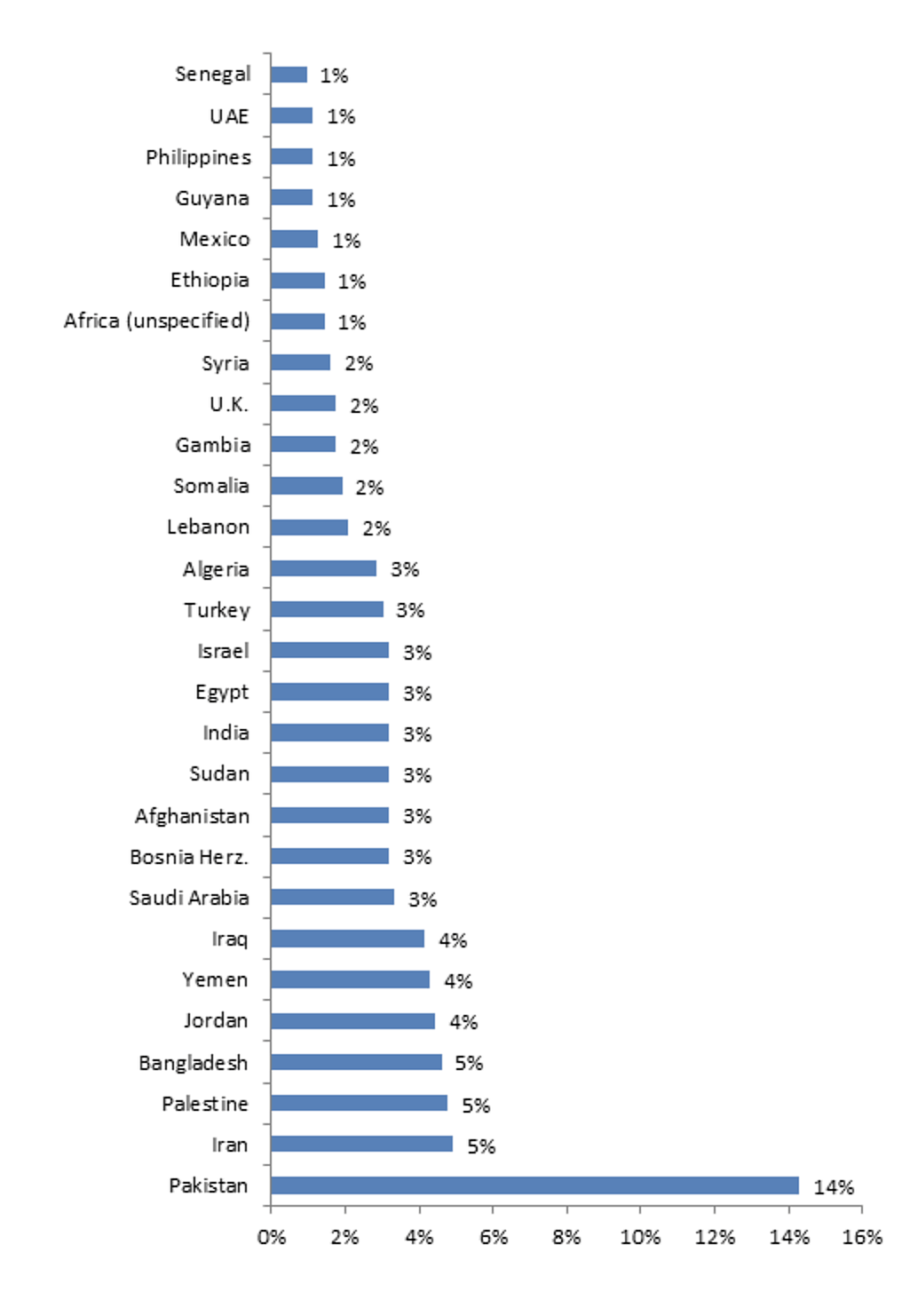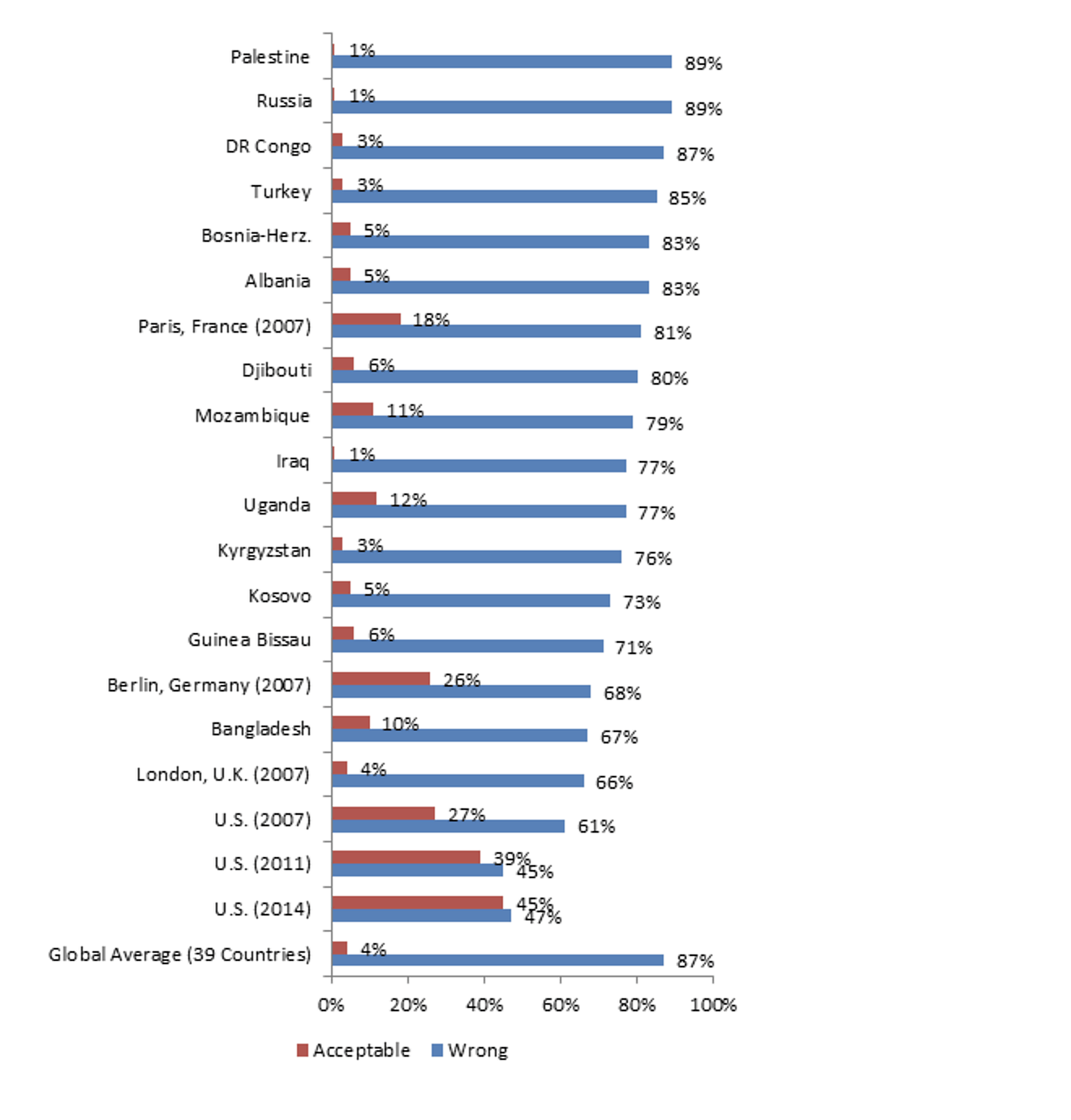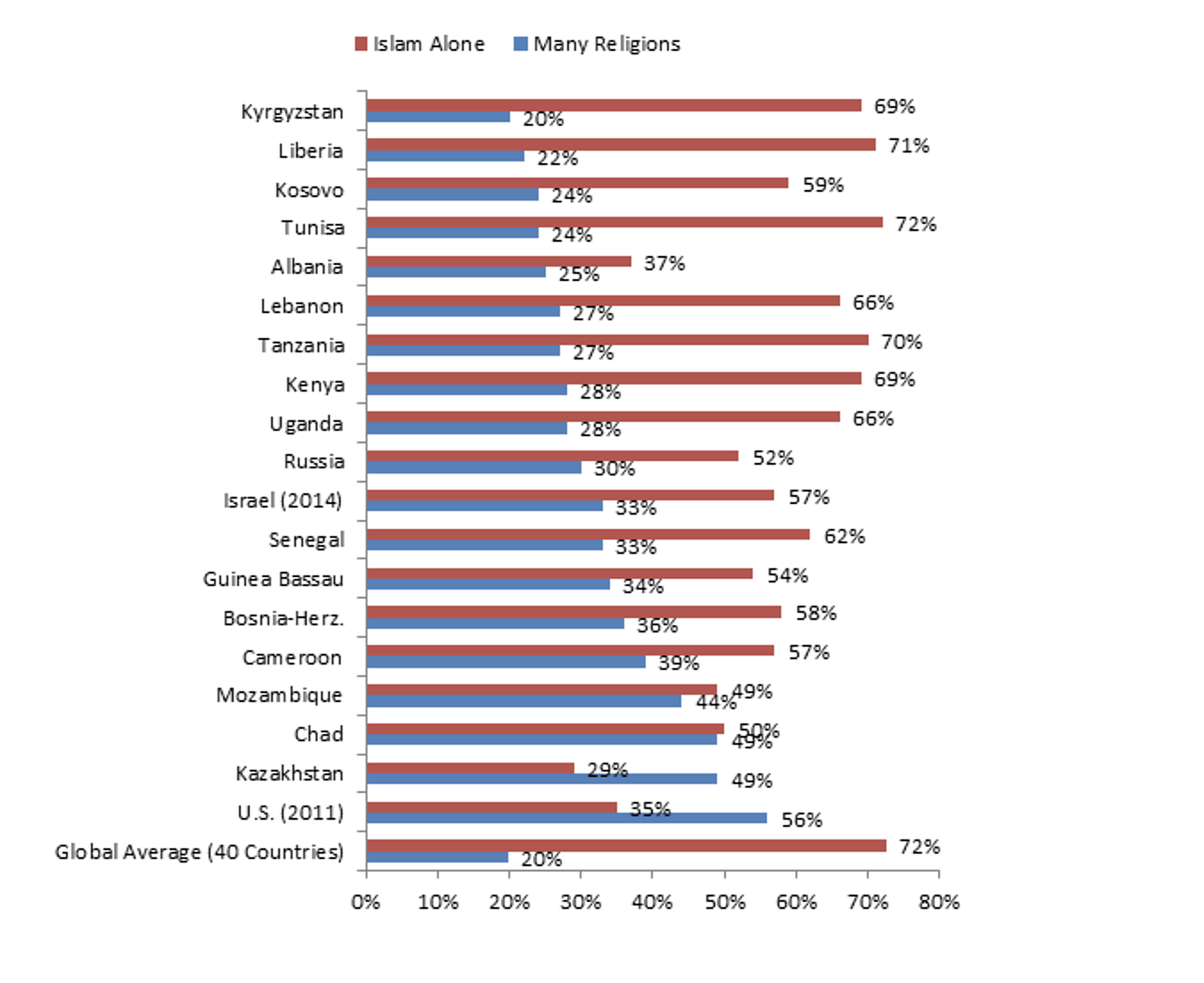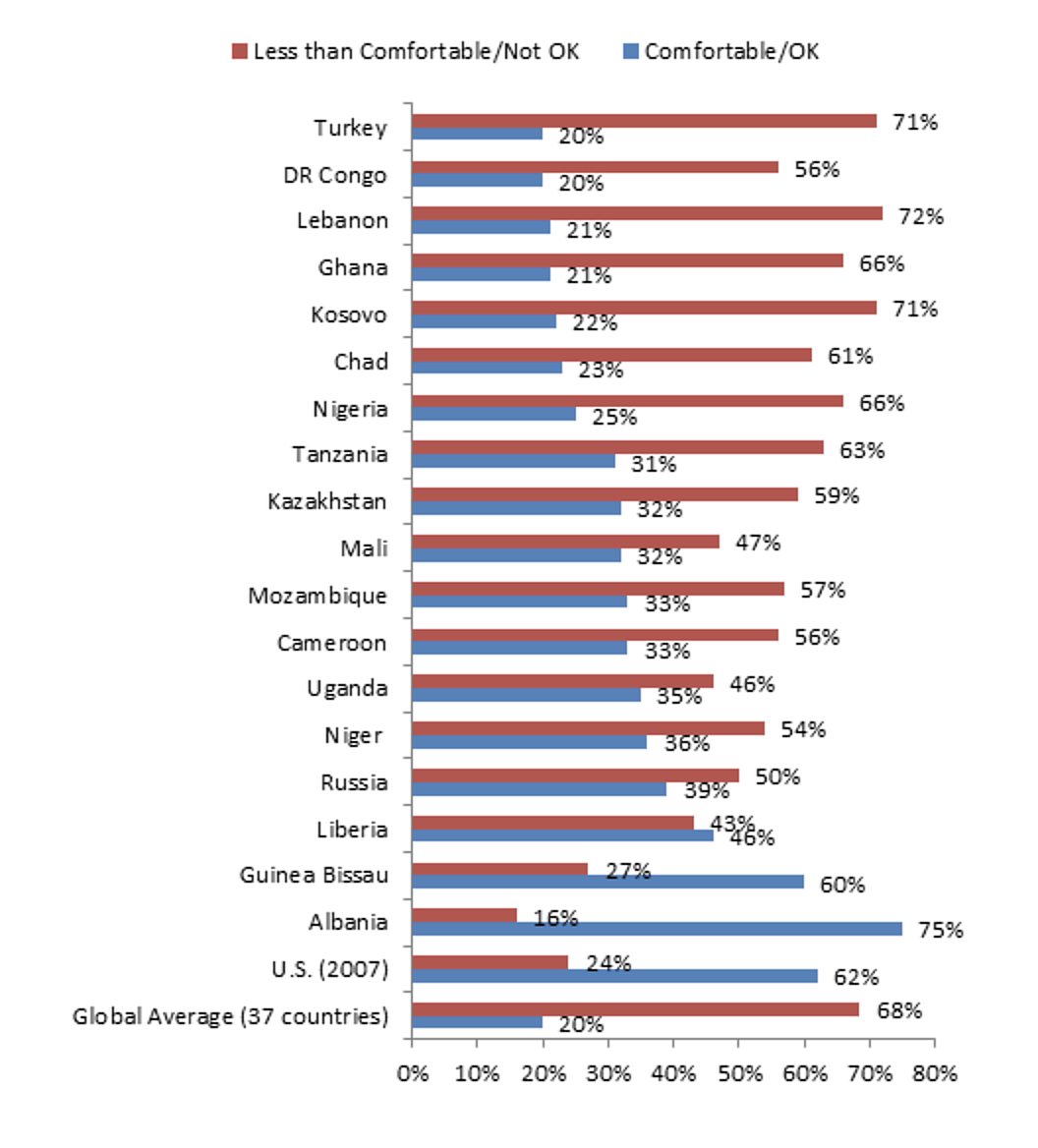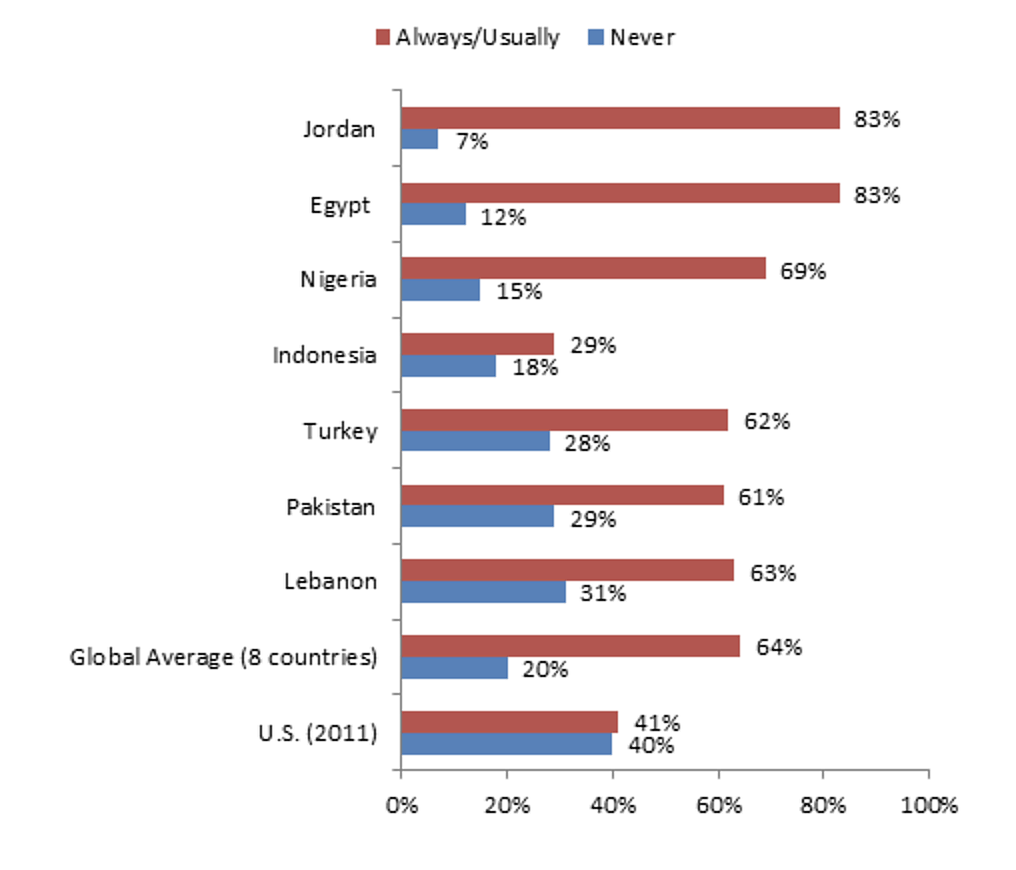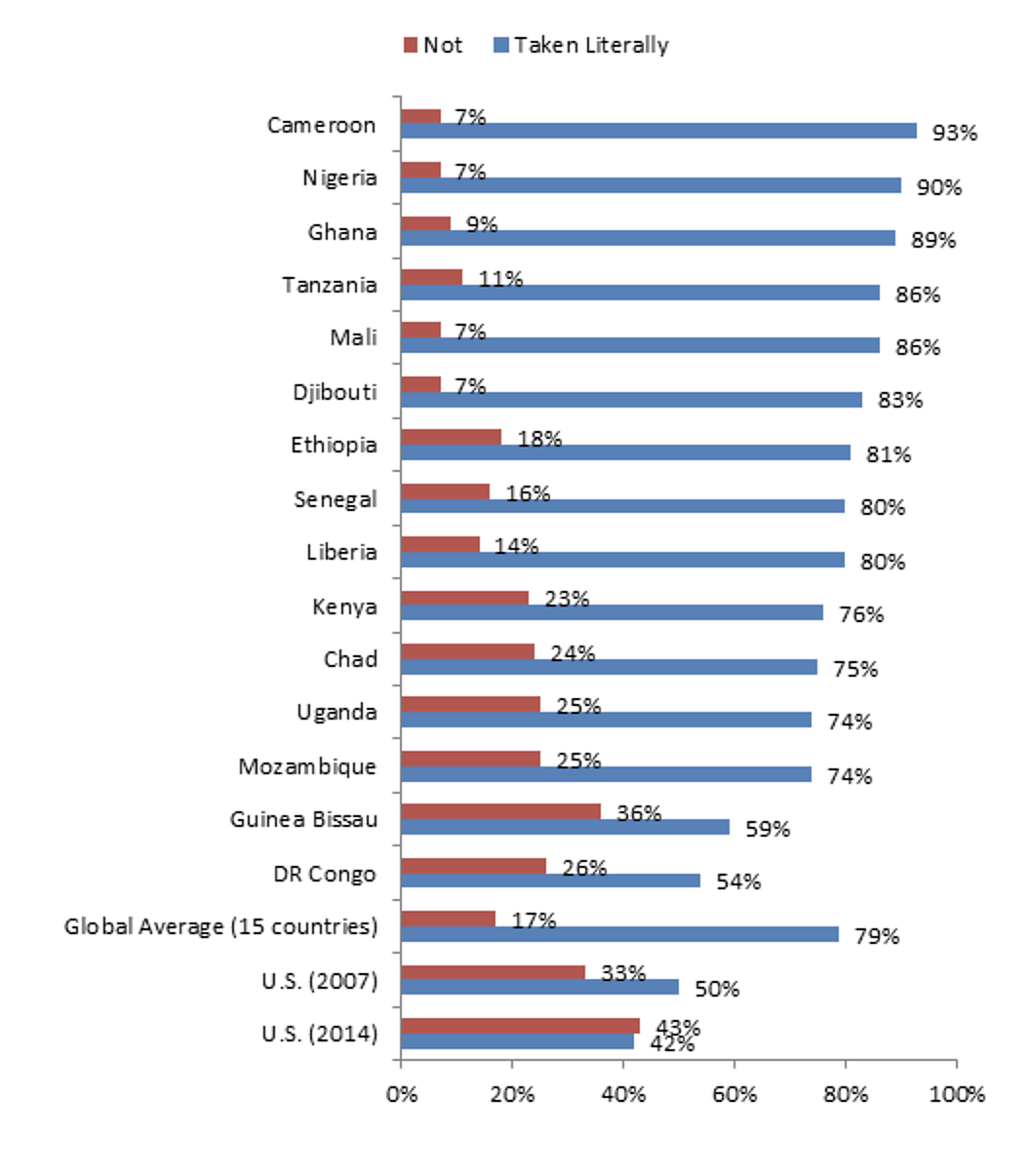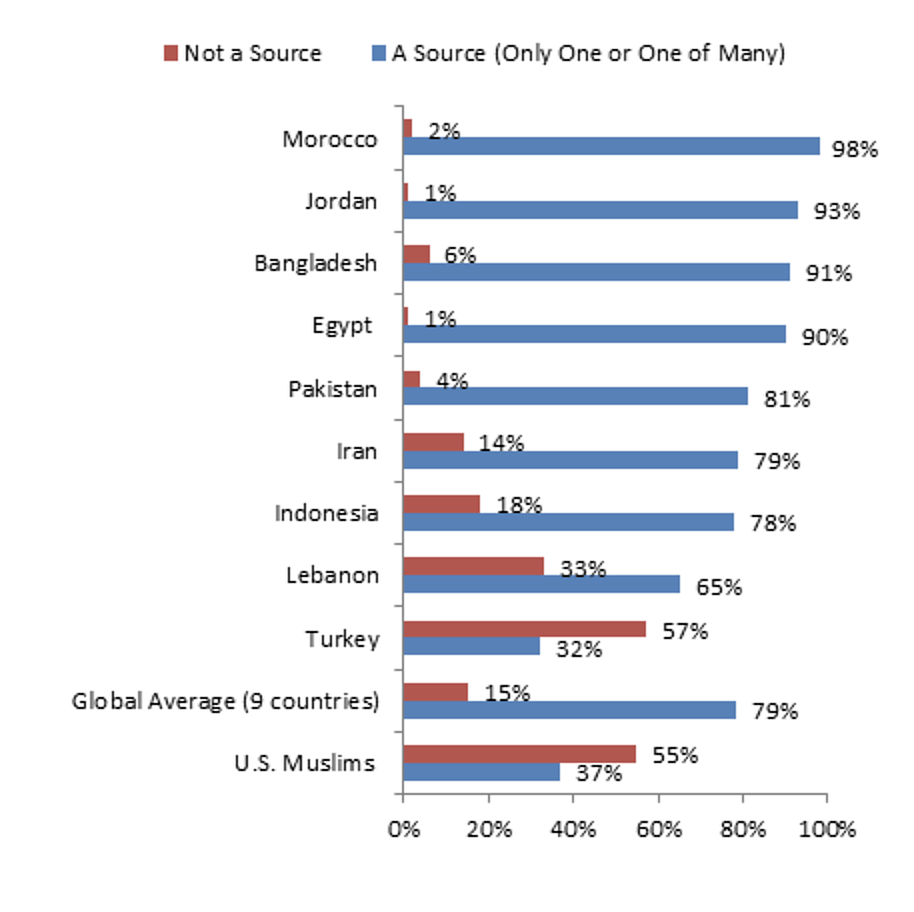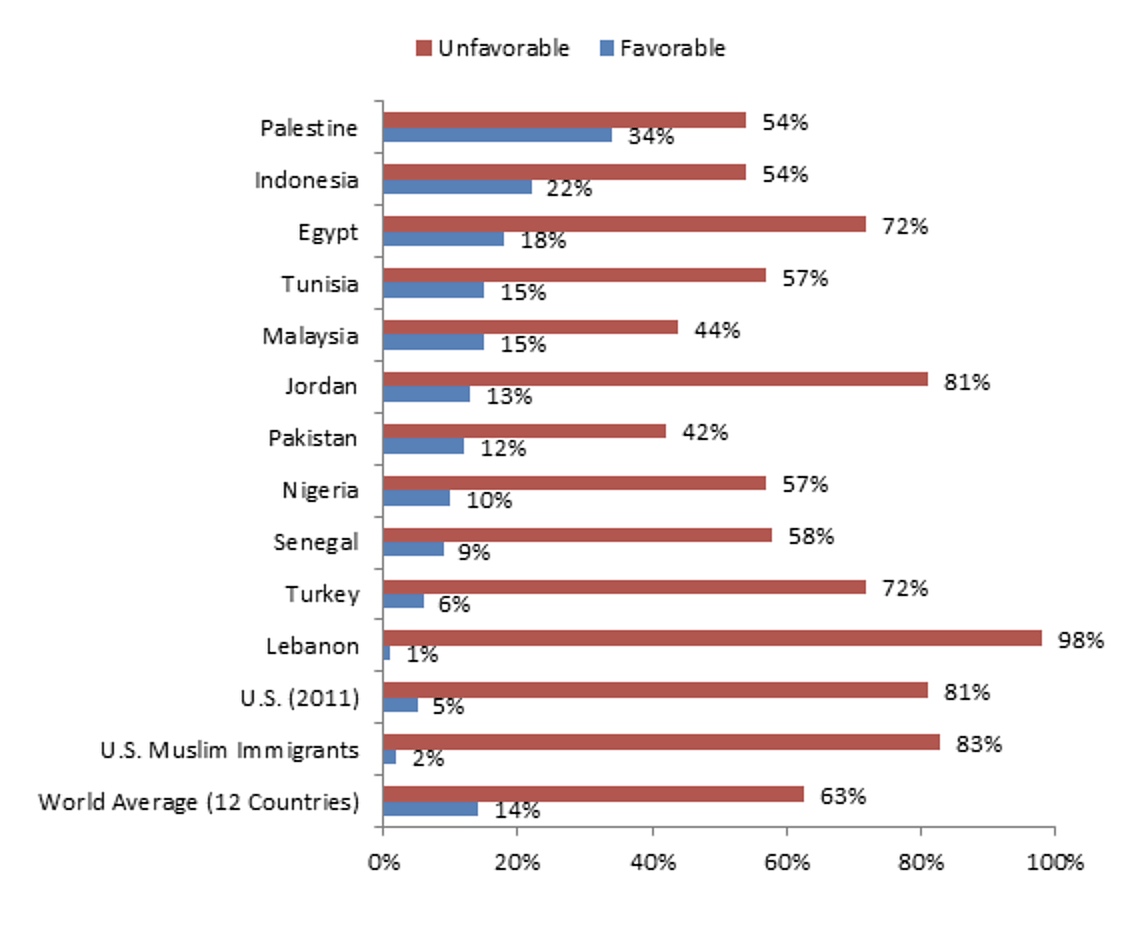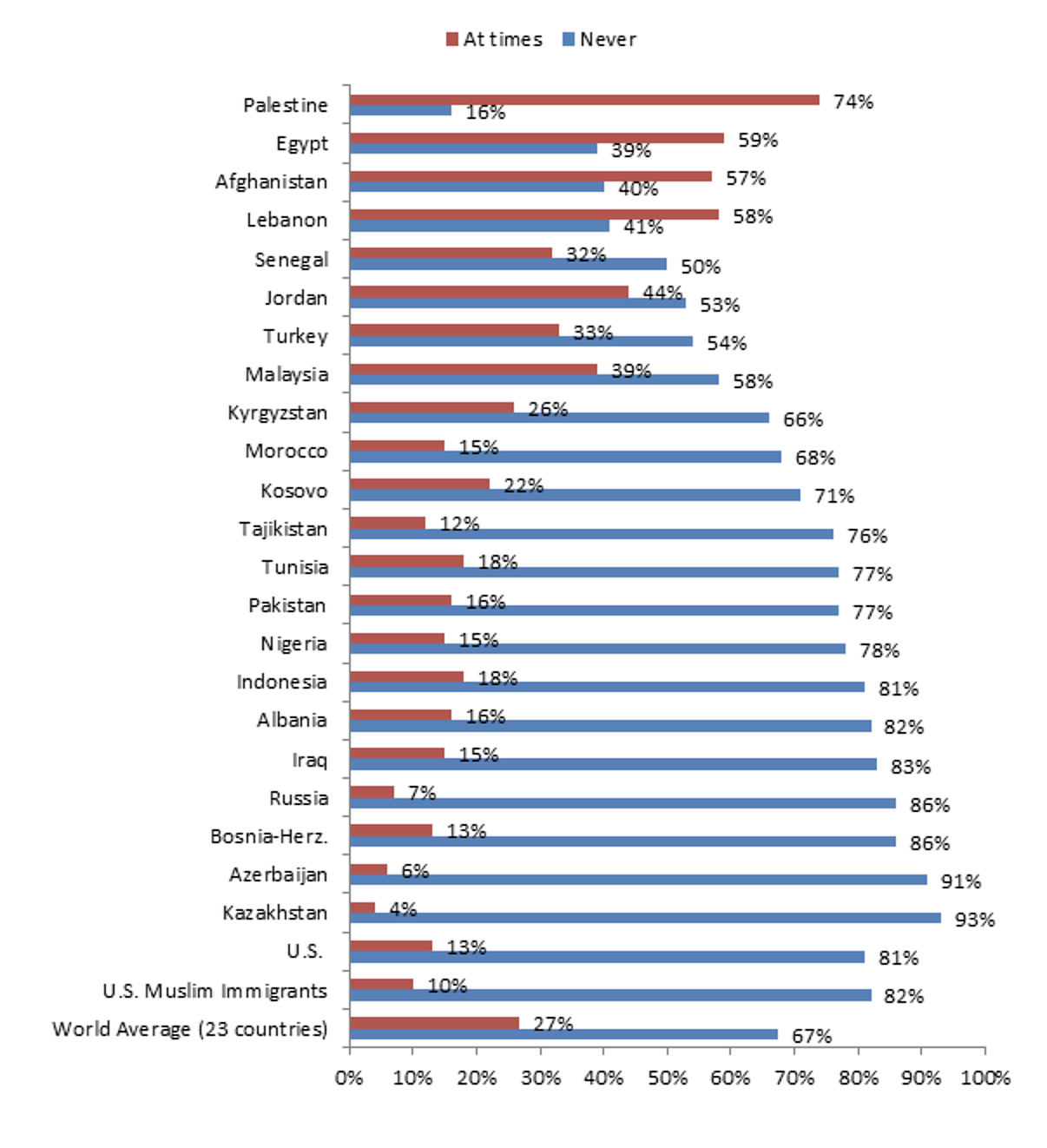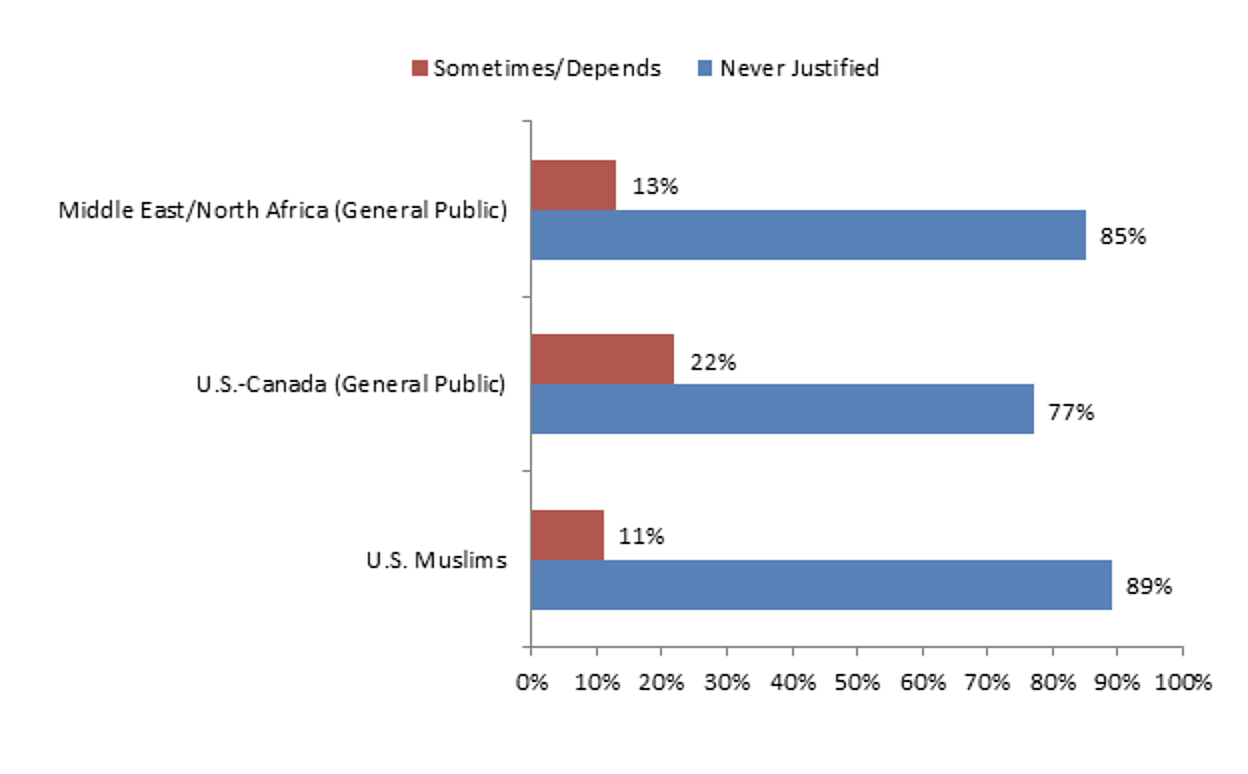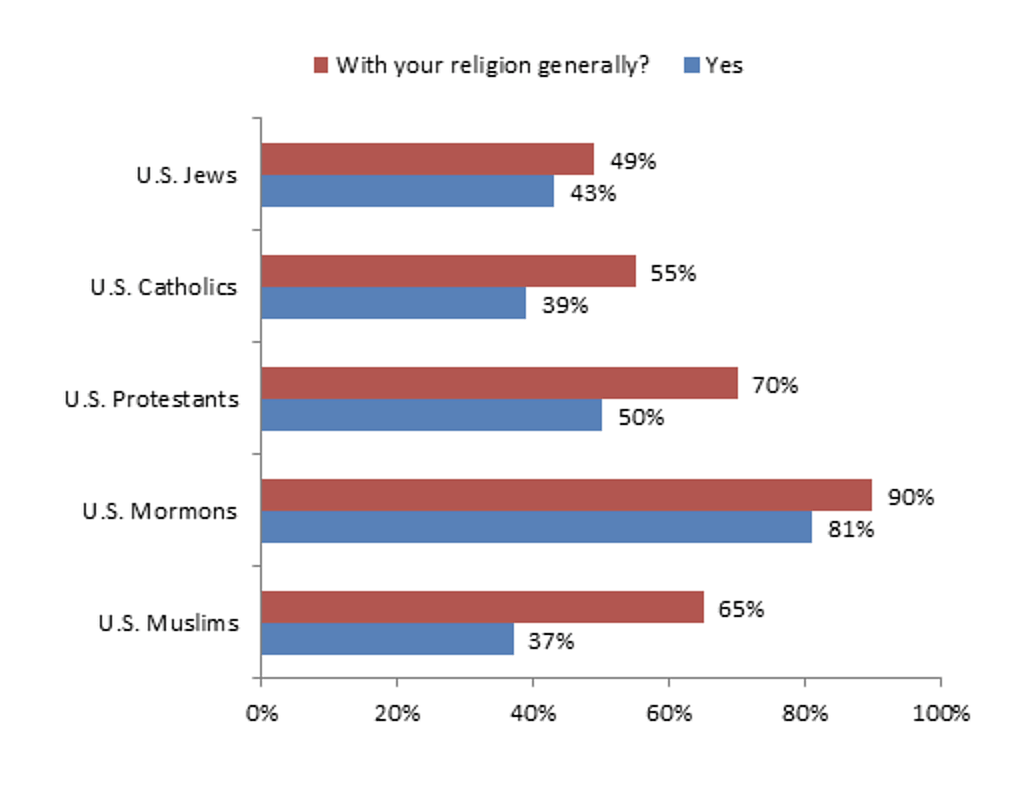Concerns about Muslim assimilation made news again this week when Donald Trump erroneously claimed that U.S. Muslim neighbors failed to report the San Bernardino shooters. But this persistent idea that U.S. Muslims are not assimilating could not be more inaccurate. In fact, U.S. Muslims—81 percent of whom are immigrants or children of immigrants—are the most socially liberal and religiously tolerant in the world and becoming more so with each passing year.
U.S. Muslims Are Adopting Americans’ Liberal Social and Religious Views
More than 80 percent of Muslim Americans are immigrants or the children of immigrants, according to the Pew Research Center’s 2014 survey. The large majority of these are immigrants who arrived since 1990. Figure 1 provides the countries of origin for U.S. Muslim immigrants. The fact that Muslim Americans are dominated by immigrants could lead to the conclusion that the views of Muslim Americans will reflect the views of Muslims worldwide. But this is not the case. They are rapidly adopting American social views and liberalizing their religious views to accommodate.
Figure 1: Countries of Origin for Muslim Immigrants (2014)
Source: Pew (2011)
As an example, the vast majority of Muslims around the world are fiercely opposed to homosexuality. Worldwide, the average country-level support across 39 countries is just 5 percent with 80 percent opposed. Yet as Figure 2 shows, in the United States in 2011, 45 percent of U.S. Muslims considered homosexuality morally acceptable—the highest in the world—compared to 47 percent who did not. While lower than the U.S. public generally, opposition to homosexuality fell 14 percentage points from 2007 to 2014, while acceptance gained 18 percentage points—a 32-point swing in less than a decade.
Figure 2: Is homosexuality morally acceptable or morally wrong?
Sources: Gallup (2008)—Germany, France, U.K.; Pew (2007, 2011, 2014)—United States; Pew (2013)—all other countries. Note that at least 90 percent of Muslims in all countries not listed considered homosexuality immoral (Azerbaijan, Kazakhstan, Indonesia, Malaysia, Thailand, Egypt, Pakistan, Jordan, Lebanon, Tunisia, Cameroon, Chad, Ethiopia, Ghana, Kenya, Liberia, Mali, Niger, Nigeria, Senegal, and Tanzania).
Another signal of their more tolerant attitudes is that a majority of Muslim Americans accept other faiths as spiritual equals. Pew Research Center found that U.S. Muslims in 2011 were unique among Muslims around the world in that they rejected the idea that Islam is the only faith leading to eternal life, instead believing that many other religions can also do so. As Figure 3 shows, a majority—56 percent—adopted the more liberal view, compared to just a country-level average of 20 percent for Muslims elsewhere.
Figure 3: Which statement comes closest to your view: Islam is the one, true faith leading to eternal life, or many religions can lead to eternal life?
Source: Pew (2011)—the United States; Pew (2013)—all others. Note that less than 20 percent of the Muslims in each of the countries not shown agreed that other religions could lead to eternal life. Those countries are: Tajikistan, Turkey, Uzbekistan, Indonesia, Malaysia, Thailand, Bangladesh, Pakistan, Egypt, Iraq, Jordan, Morocco, Palestine, Djibouti, Ethiopia, Ghana, DR Congo, Mali, Niger, and Nigeria
This pluralistic faith could be a consequence of the fact that in the United States, only 48 percent of Muslim Americans say that “all or most” of their friends are other Muslims, compared to 95 percent globally. Given their much more ready acceptance of other religions and their high level of interaction between members of other faiths, it is also not very surprising that Muslim Americans appear to be the most permissive of inter-faith marriages.
Unfortunately, Pew asked slightly different questions of Muslims in the United States than internationally, but 62 percent of U.S. Muslims said that it would be “OK” to marry a non-Muslim in 2007 (Figure 4). By comparison, the country-level average elsewhere around the world shows that only 20 percent of Muslims in 2011 would be comfortable with a child’s marriage to a Christian. Granting that people may be more likely to be “uncomfortable” with their own child’s activities than the same activity in the abstract, this is still a stark difference in attitudes. It’s also worth noting that 16 percent of U.S. Muslims were already living with a spouse or partner of a different religion in 2007.
Figure 4: Non‑U.S. Question: How comfortable would you be if a child of yours someday married a Christian? U.S. Question: Do you personally think it is OK for a Muslim to marry someone who is not a Muslim?
Source: Pew (2011); Pew (2007). Note that less than 20 percent of the Muslims in each of the countries not shown felt comfortable with inter-faith marriages. Those countries are:Djibouti, Kenya, Kyrgyzstan, Ethiopia, Senegal, Bosnia-Herz., Morocco, Tunisia, Malaysia, Uzbekistan, Bangladesh, Tajikistan, Palestine, Iraq, Azerbaijan, Pakistan, Indonesia, Egypt, and Jordan.
Another interesting example of the modernizing trend in the United States is the extent to which Muslims in the United States are losing cultural expressions of their faith common in other countries. In a smaller yet telling Pew survey of Muslims in 8 countries, Muslim Americans were the most likely to never wear a hijab and the least likely to always or usually wear one—just 41 percent of U.S. Muslims do so compared to 61 percent internationally (Figure 5).
Figure 5: When you are out in public, how often do you wear the headcover or hijab?
Source: Pew (2011)
The willingness of Muslim Americans to depart from the strict requirements in Islamic law may stem from their more liberal views on scriptural interpretation. Muslim Americans are half as likely as other Muslims to believe that the Quran should be taken literally. A plurality in the United States favors not taking the Quran literally—43 percent to 42 percent—compared to the strong majority in other countries that favors literal interpretation—79 percent to 17 percent. As Figure 6 shows, Muslim Americans’ views are also trending strongly against the literal view—dropping from a net 17 percentage point in favor to a net 1 percentage point against from 2007 to 2014.
Figure 6: Is the Quran to be taken literally, word for word?
Sources: Pew (2007); Pew (2011); Pew (2014)
This acceptance of liberal values and rejection of a strict interpretation of the Quran is reflected in the share of Muslim Americans who oppose using the Quran as a source of legislation in the United States. In 2006, Gallup found support for using Sharia as at least one source for the law at a worldwide country-level average of 79 percent (Figure 7). The Institute for Social Policy and Understanding asked a very similar question of U.S. Muslims in 2016 and found that 55 percent opposed using “their religion” as even one source out of many for U.S. laws.
Figure 7: Should Sharia/your religion be a source of legislation?
Sources: Gallup (2006); ISPU (2016)
Support for Terrorism and Extremism Much Lower among U.S. Muslims
Another sign that U.S. Muslims are adopting American social norms is the extent to which they reject radical ideological groups, like al Qaeda and the Islamic State. Pew also conducted a survey of Muslims in 12 countries that asked about their views on al Qaeda. Of all the Muslims surveyed, only Lebanese had a more negative view of the Sunni terrorist group al Qaeda than U.S. Muslims (Figure 8). Just 5 percent of Muslim Americans had a favorable view of the group, compared to 81 percent who did not. The opposition was more pronounced among U.S. Muslim immigrants—just 2 percent saw al Qaeda favorably compared to 83 percent who didn’t. Both of which are within the poll’s margin of error (+-5%).
Figure 8: Do you have a favorable or unfavorable view of al Qaeda?
Source: Pew (2011)—United States; Pew (2013)—all others
U.S. Muslims also more strongly oppose violence in the name of Islam. Pew asked Muslims in 23 countries how often suicide bombing “and other forms of violence against civilian targets in order to defend Islam from its enemies” is justified. As Figure 9 shows, Muslims around the world are overwhelmingly opposed to this type of violence. At a country-level, 67 percent of Muslims oppose these attacks in all cases, compared to 27 percent who believe they can be justified at times (“rarely, sometimes, often”). In the United States, Muslims oppose all such attacks to defend Islam 81 percent to 13 percent. Among Muslim immigrants, opposition is more pronounced—82 percent to 10 percent.
Figure 9: How often do you think suicide bombing and other forms of violence against civilian targets are justified in order to defend Islam from its enemies?
Sources: Pew (2011)—United States; Pew (2013)—all others
In 2011, Gallup also conducted a similar poll that found a low level of support for violence against civilians among U.S. Muslims compared to countries in the Middle East and North Africa (Figure 10). They opposed such attacks in all cases 89 percent to 11 percent, compared to 85 percent to 13 percent in the other countries. They also had significantly lower levels of support for violence against civilians than U.S. and Canadian public generally, who opposed it in all cases just 77 percent to 22 percent.
Figure 10: Do you think that for an individual person or a small group of persons to target and kill civilians is never justified?
Sources: Gallup (2011)—United States; Gallup (2011)—all others
These differences between Muslim Americans and other Muslims around the world influence how U.S. Muslims see themselves in the world. Among all religious groups in the United States, Muslim Americans are the least likely to identify strongly with members of their religion internationally. Just 37 percent do so, despite the fact that Muslim Americans are the least likely to be U.S. citizens. As seen in Figure 11, they also had the largest gap between those who identify strongly with their religion and those who identify with their co-religionists around the world. They were also more likely to identify strongly with their adopted U.S. nationality than with their religion generally.
Figure 11: Do you identify strongly with those worldwide who share your religious identity?
Sources: Gallup (2011)
Explanations for Liberal Views and Policy Implications
This survey of Muslim assimilation demonstrates three important facts in the debate over Muslim immigration: first, that Muslim Americans have taken markedly more liberal views on social, religious, and political subjects than Muslims elsewhere; second, that Muslim Americans are quickly adopting the views of other Americans; third, that Muslim immigrants in the United States are less likely to support al Qaeda, violence against civilians, and aspects of strict Islamic law than native-born Muslim Americans.
There are two possibilities for the divergence in views between Muslims in the United States and those elsewhere: either immigrants who choose to come to the United States have views most similar to Americans, or immigrants who immigrate to the United States quickly adopt the norms of their new home. To put the question another way, either Muslim immigrants to the United States are unique or the United States is unique in its ability to integrate immigrants.
As has already been seen, the United States appears to be quickly changing the views of immigrants after they arrive, but this phenomenon does not rule out the possibility that Muslim immigrants to the United States started with more liberal views to begin with. One possible argument against this view is that the top origin countries (Figure 1) for U.S. Muslims are among the least liberal in the world.
If the United States does have a liberalizing effect on the views and practices of fundamentalist Muslims, then large-scale immigration of Muslims could be a viable way to increase the influence of liberal Muslims in the world.
